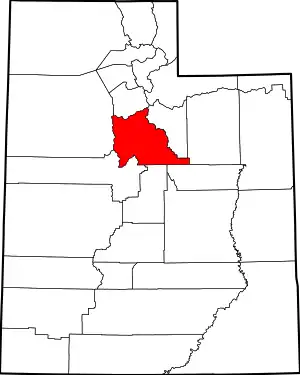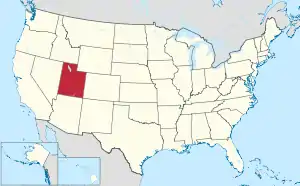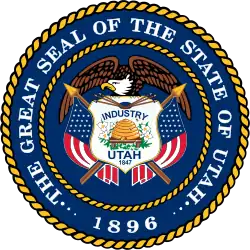Utah County, Utah
Utah County is a county in the U.S. state of Utah. As of the 2010 United States Census, the population was 516,564,[1] thus making it Utah's second-most populous county. The county seat and largest city is Provo,[2] which is the state's third-largest city.
Utah County | |
|---|---|
_at_Historic_Utah_County_Courthouse%252C_Jul_15.jpg.webp) Historic Utah County Courthouse | |
 Location within the U.S. state of Utah | |
 Utah's location within the U.S. | |
| Coordinates: 40°07′N 111°40′W | |
| Country | |
| State | |
| Founded | January 31, 1850 (created) April 18, 1852 (organized) |
| Named for | Ute Tribe |
| Seat | Provo |
| Largest city | Provo |
| Area | |
| • Total | 2,144 sq mi (5,550 km2) |
| • Land | 2,003 sq mi (5,190 km2) |
| • Water | 141 sq mi (370 km2) 6.6% |
| Population (2010) | |
| • Total | 516,564 |
| • Estimate (2019) | 636,235 |
| • Density | 240/sq mi (93/km2) |
| Time zone | UTC−7 (Mountain) |
| • Summer (DST) | UTC−6 (MDT) |
| Congressional districts | 3rd, 4th |
| Website | www |
Utah County is part of the Provo-Orem, UT Metropolitan Statistical Area as well as the Salt Lake City-Provo-Orem, UT Combined Statistical Area.
In 2010, the center of population of Utah was in Utah County, in the city of Saratoga Springs.[3]
Utah County is one of seven counties in the United States to have the same name as its state.[4]
History
The legislature of the State of Deseret created a county on January 31, 1850,[5] to govern the civic affairs of Utah Valley, which by the 1850s was bustling with newly arrived settlers. The county name derived from the valley name, which derived from the Spanish name (Yuta) for the Ute Indians. The State of Deseret was dissolved soon after (April 5, 1851), but the counties it had set in place continued in existence. There is little record of any official activity conducted by the fledgling county until April 18, 1852, when a full slate of county officials was published and recordkeeping began. The first courthouse was built in central Provo in 1866–67. It was soon outgrown, and was replaced by a second courthouse (1872–73). By the 1920s this building was also cramped, and the decision was made to erect a combined city-county building, which was completed in 1926.[6]
The county's boundaries were adjusted in 1852, 1854, 1856, 1862, 1880, and 1884. It has retained its present boundary since 1884.[7]
Geography
Utah County terrain ranges from stiff mountain ranges in the east (the Wasatch Range, dropping steeply to a large lake-filled valley. Most of the comparatively level ground is dedicated to agriculture or developed uses, while most of the steep terrain is covered with arid-climate forestation.[8] The county generally slopes to the west and north, with its highest point (Mt. Nebo in the southern part of the county), at 11,928' (3636m) ASL.[9] The county has an area of 2,144 square miles (5,550 km2), of which 2,003 square miles (5,190 km2) is land and 141 square miles (370 km2) (6.6%) is water.[10]
Utah Valley lies at the center of the county, lined by the mountains of the Wasatch Range on the east. Utah Lake occupies a large part of the valley. The elevation ranges from 4,487 feet (1,368 m) above sea level at the lake to 11,928 feet (3,636 m) at the peak of Mount Nebo.
Major highways[8]
Protected areas[8]
- Ashley National Forest (part)
- Black Hawk Campground (US Forest Service)
- Finish of the Provo River Parkway
- Manti-La Sal National Forest (part)
- Mount Timpanogos
- Powell Slough Waterfowl Management Area
- Rock Island Waterfowl Management Area
- Scofield State Park (part)
- Starvation Wildlife Management Area
- Timpanogos Cave National Monument
- Uinta-Wasatch-Cache National Forest (part)
- Utah Lake State Park
Lakes[8]
- Utah Lake
- Provo Bay (an extension of Utah Lake)
- Scofield Reservoir (part)
Demographics
| Historical population | |||
|---|---|---|---|
| Census | Pop. | %± | |
| 1850 | 2,026 | — | |
| 1860 | 8,248 | 307.1% | |
| 1870 | 12,203 | 48.0% | |
| 1880 | 17,973 | 47.3% | |
| 1890 | 23,768 | 32.2% | |
| 1900 | 32,456 | 36.6% | |
| 1910 | 37,942 | 16.9% | |
| 1920 | 40,792 | 7.5% | |
| 1930 | 49,021 | 20.2% | |
| 1940 | 57,382 | 17.1% | |
| 1950 | 81,912 | 42.7% | |
| 1960 | 106,991 | 30.6% | |
| 1970 | 137,776 | 28.8% | |
| 1980 | 218,106 | 58.3% | |
| 1990 | 263,590 | 20.9% | |
| 2000 | 368,540 | 39.8% | |
| 2010 | 516,564 | 40.2% | |
| 2019 (est.) | 636,235 | [11] | 23.2% |
| US Decennial Census[12] 1790–1960[13] 1900–1990[14] 1990–2000[15] 2010–2019[1] | |||
2000 census
As of the 2000 United States Census, there were 516,564 people, 140,602 households, and 114,350 families in the county. The population density was 258/sqmi (99.6/km2). There were 148,350 housing units, at an average density of 74.1/sqmi (28.6/km2). The county's racial makeup was 89.4% White, 0.5% Black or African American, 0.6% American Indian or Alaska Native, 1.4% Asian, 0.8% Native Hawaiian or other Pacific Islander, 4.6% some other race, and 2.7% from two or more races. 10.8% of the population were Hispanic or Latino of any race.
There were 140,602 households, out of which 47.7% had children under the age of 18 living with them, 69.9% were headed by married couples living together, 8.0% had a female householder with no husband present, and 18.7% were non-families. 11.6% of all households were made up of individuals, and 4.4% were someone living alone who was 65 years of age or older. The average household size was 3.57, and the average family size was 3.88.
The county's population was spread out, with 35.2% under the age of 18, 15.8% from 18 to 24, 28% from 25 to 44, 14.5% from 45 to 64, and 6.5% who were 65 years of age or older. The median age was 24.6 years. For every 100 females, there were 100.3 males. For every 100 females age 18 and over, there were 97.7 males.
At the 2000 census, the median income for a household in the county was $45,833, and the median income for a family was $50,196. Males had a median income of $37,878 versus $22,656 for females. The per capita income for the county was $15,557. About 6.80% of families and 12.00% of the population were below the poverty line, including 8.40% of those under age 18 and 4.80% of those age 65 or over.
The five most reported ancestries in Utah County are:[16]
Religion
Government

The government is a three-member elected county commission elected at-large. Other elected officials include the county sheriff, the county clerk, county recorder, county assessor, county surveyor, county treasurer, and the county attorney.
In 2020, Utah County voters rejected Proposition 9, which would have changed the county's government to a five-member elected county council with an elected county mayor.[18]
Social issues
Utah County saw high rates of opioid and other prescription drug addiction from the mid-2000s onwards, foreshadowing the national opioid crisis. The 2008 documentary Happy Valley examined the problem.[19]
Giving USA, which reports on charitable giving in the US, named Utah County as one of the three most generous counties in philanthropic donations, alongside San Juan County, Utah and Madison County, Idaho.[20]
In 2019, one in eight people and one in six children in the county did not have sufficient food.[21]
Infrastructure
The I-15 CORE project added multiple lanes on Interstate 15 through most of Utah County. This expanded 24 miles (39 km) of freeway and was completed in 2012.[22] Other construction projects by UDOT have been done on I-15 since then, including the Technology Corridor project and the Point of the Mountain project.
Politics
Utah County has been referred to as "the most Republican county in the most Republican state in the United States".[23] It has only supported a Democrat for president nine times since statehood, and has not supported a Democrat for president since 1964. Indeed, 1964 is the last time a Democrat has even managed 35 percent of the county's vote.
In the 1992 presidential election, George H. W. Bush received the most votes and Bill Clinton was third in votes received. In the 2004 presidential election, 85.99% voted for George W. Bush.[24] In the 2008 U.S. presidential election, the county voted for John McCain by a 58.9% margin over Barack Obama, compared to McCain winning by 28.1% statewide.[25] Eight other Utah counties voted more strongly in favor of McCain.[26] In the 2012 election, Mitt Romney received 88.32% of the vote. In the 2016 election, it gave a slim majority of the vote to Donald Trump, and over 30% of the vote to independent candidate Evan McMullin, who outperformed Hillary Clinton in the county. This was McMullin's largest share of the vote in any county in Utah and his second best nationwide after Madison County, Idaho. The Democrats received a much higher vote share in 2020 of over 75,000 - they had never previously received more than 30,000 votes in the county.
| Year | Republican | Democratic | Third parties |
|---|---|---|---|
| 2020 | 66.7% 192,812 | 26.3% 76,033 | 7.0% 20,256 |
| 2016 | 50.2% 102,182 | 14.0% 28,522 | 35.8% 72,938 |
| 2012 | 88.3% 156,950 | 9.7% 17,281 | 2.0% 3,482 |
| 2008 | 77.7% 122,224 | 18.8% 29,567 | 3.5% 5,488 |
| 2004 | 86.0% 128,269 | 11.6% 17,357 | 2.4% 3,547 |
| 2000 | 81.7% 98,255 | 13.7% 16,445 | 4.6% 5,556 |
| 1996 | 71.1% 69,653 | 18.7% 18,291 | 10.3% 10,087 |
| 1992 | 56.8% 61,398 | 13.0% 14,090 | 30.2% 32,690 |
| 1988 | 77.2% 68,134 | 21.0% 18,533 | 1.8% 1,560 |
| 1984 | 82.6% 72,284 | 16.9% 14,801 | 0.5% 419 |
| 1980 | 83.4% 71,859 | 14.1% 12,166 | 2.4% 2,096 |
| 1976 | 69.5% 49,328 | 25.8% 18,327 | 4.7% 3,338 |
| 1972 | 70.9% 42,179 | 18.2% 10,828 | 10.9% 6,453 |
| 1968 | 59.0% 29,226 | 33.6% 16,629 | 7.4% 3,673 |
| 1964 | 46.6% 20,912 | 53.4% 23,936 | |
| 1960 | 54.0% 23,057 | 46.0% 19,626 | 0.1% 25 |
| 1956 | 66.6% 25,371 | 33.4% 12,747 | |
| 1952 | 57.7% 20,913 | 42.3% 15,327 | |
| 1948 | 44.8% 13,395 | 54.2% 16,191 | 1.0% 300 |
| 1944 | 38.7% 9,946 | 61.1% 15,722 | 0.2% 45 |
| 1940 | 36.5% 8,740 | 63.3% 15,168 | 0.2% 48 |
| 1936 | 29.8% 6,173 | 69.5% 14,387 | 0.7% 135 |
| 1932 | 38.7% 7,953 | 59.1% 12,140 | 2.2% 443 |
| 1928 | 52.2% 8,771 | 47.3% 7,955 | 0.5% 81 |
| 1924 | 46.3% 6,946 | 34.8% 5,226 | 18.9% 2,838 |
| 1920 | 53.3% 7,752 | 43.9% 6,377 | 2.8% 403 |
| 1916 | 37.5% 5,201 | 59.3% 8,235 | 3.3% 451 |
| 1912 | 35.5% 4,185 | 39.3% 4,636 | 25.3% 2,986 |
| 1908 | 54.8% 6,373 | 42.9% 4,984 | 2.3% 269 |
| 1904 | 59.2% 6,490 | 38.7% 4,243 | 2.2% 239 |
| 1900 | 51.0% 5,698 | 48.2% 5,391 | 0.8% 90 |
| 1896 | 21.7% 2,039 | 78.3% 7,375 |
Utah County is split between two congressional districts. Most of the county is in the 3rd District, represented by Republican John Curtis. The northern portion is in the 4th District, represented by Republican Burgess Owens.
The county's Republican bent runs right through state and local politics. All five state senators representing the county, as well as all 14 state representatives,[28] are Republicans.
Education
School districts
Universities
- Brigham Young University (private)
- Utah Valley University (Utah State owned)
- Mountainland Technical College (Utah State owned)
Communities

.jpg.webp)
Cities
- Alpine
- American Fork
- Bluffdale (part)
- Cedar Hills
- Draper (part)
- Eagle Mountain
- Elk Ridge
- Highland
- Lehi
- Lindon
- Mapleton
- Orem
- Payson
- Pleasant Grove
- Provo (county seat)
- Salem
- Santaquin (part)
- Saratoga Springs
- Spanish Fork
- Springville
- Vineyard
- Woodland Hills
Towns
Census-designated places
Unincorporated communities[8]
- Aspen Grove
- Birdseye
- Colton
- Covered Bridge Canyon
- Lant
- Pines
- Silver Lake Summer Home Area
- Sky View
- Soldier Summit (part)
- Springdell
- Sundance
- Verda
- Vivian Park
- Wildwood
Former communities
- Caryhurst (now within Provo city limits)
- Christmas City (area is now partially in Provo and partially in Orem)
- Dividend
- Forest City
- Homansville
- Ironton (now within Provo city limits)
- Leland (absorbed by Spanish Fork)
- Manila (former township, annexed by Pleasant Grove in 1998)
- Manning
- Mill Fork
- Mosida
- Thistle
- Tucker
- West Portal
In popular culture
- The 2003 book Under the Banner of Heaven written by Jon Krakauer discusses locations throughout Utah County.
- The 1984 film Footloose was filmed at various locations in Utah County: American Fork, Lehi, Orem, Payson, and Provo
References
- "State & County QuickFacts". United States Census Bureau. Retrieved December 30, 2013.
- "Find a County". National Association of Counties. Retrieved June 7, 2011.
- "Centers of Population by State: 2010". US Census Bureau. Retrieved May 5, 2014.
- The other six are Arkansas, Hawaii, Idaho, Iowa, New York, and Oklahoma Counties. Joseph Nathan Kane; Charles Curry Aiken (2005). The American Counties: Origins of County Names, Dates of Creation, and Population Data, 1950-2000. Scarecrow Press. ISBN 978-0-8108-5036-1.
- The Utah County website "History" cites January 28, 1850 as the date of establishing Utah County
- "Historic Utah County Courthouse" Utah County website (accessed 26 March 2019)
- "Utah: Individual County Chronologies". Newberry Library. 2008. Retrieved March 26, 2019.
- Utah County UT Google Maps (accessed 26 March 2019)
- "Utah County High Points" Peakbagger (accessed 26 March 2019)
- "2010 Census Gazetteer Files". US Census Bureau. August 22, 2012. Retrieved June 26, 2015.
- "Population and Housing Unit Estimates". Retrieved March 26, 2020.
- "US Decennial Census". US Census Bureau. Retrieved December 30, 2013.
- "Historical Census Browser". University of Virginia Library. Retrieved December 30, 2013.
- "Population of Counties by Decennial Census: 1900 to 1990". US Census Bureau. Retrieved December 30, 2013.
- "Census 2000 PHC-T-4. Ranking Tables for Counties: 1990 and 2000" (PDF). US Census Bureau. Retrieved December 30, 2013.
- "Utah County, Utah, Ancestry & Family History". ePodunk Inc. Retrieved October 19, 2012.
- "Utah County, Utah (UT) Religion Statistics Profile - Provo, Orem, Pleasant Grove, American Fork, Springville". City-data.com. Retrieved October 19, 2012.
- Cleary, Kaela (November 5, 2020). "Utah County voters say 'no' to Prop 9". The Daily Universe. Retrieved December 7, 2020.
- "Happy Valley (2008)". Amazon.com.
- Giving USA 2003 (PDF) (Report). AAFRC Trust for Philanthropy (www.afpnet.org).
- Smith, Dave (August 18, 2019). "Community Action: With 13% of the county struggling with hunger, how to host a food drive in Utah". Daily Herald. Retrieved January 14, 2020.
- "New changes on I-15 in Utah County". Retrieved October 28, 2011.
- Krakauer, Jon (2003). Under the Banner of Heaven. New York: Doubleday. p. 78.
- "Utah County General Election, Official Results". UtahCounty.Gov, the Official Website of Utah County Government (http://www.utahcounty.gov). November 2, 2004.
- "US Election Atlas". United States Presidential Election Results. David Leip.
- "State of Utah County Election Results". NPR. November 21, 2008. Archived from the original on February 18, 2012.
- Leip, David. "Atlas of US Presidential Elections". uselectionatlas.org. Retrieved March 31, 2018.
- Hesterman, Billy. "Lawmakers say Utah County did well in redistricting process". Daily Herald. Retrieved October 19, 2011.
- "Utah School Districts & Charter Schools" (PDF). Utah State Office of Education. July 25, 2012. Retrieved October 19, 2012.
External links
| Wikimedia Commons has media related to Utah County, Utah. |

